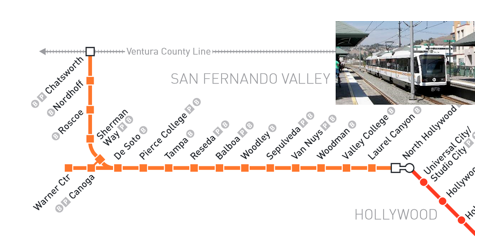PERSPECTIVE-The Orange Line busway has been a huge success, especially when you consider the comparatively low construction costs versus what was incurred for light rail systems serving the region.
Ridership tripled to 22,000 per weekday in its first year of operation in 2005. Weekday boardings are currently at 25,873, down about 2,000 from a year ago, but still impressive.
I have ridden the Orange Line between North Hollywood and Woodland Hills on a few occasions. It was comfortable, reliable, affordable and beat driving on the 101.
But its capacity is also getting maxed out.
Despite the slight drop in ridership, the buses are crowded most of the time. Waves of riders exit at the North Hollywood station and swarm the Red Line platform for the connection to downtown. I might add that the Red Line fills up quickly during the morning rush.
Upgrading to higher passenger capacity light rail makes sense, then, but not without modifications to the right-of-way and the parking facilities serving the passengers.
At-grade crossings are the bane of any railroad. The potential for collisions between trains and vehicles is ever-present; therefore, the trains (or buses, in the case of the Orange Line) must decelerate when approaching an intersection between the tracks and a street. That’s time lost. On a system with many stops, it adds up to several minutes which can make the difference in making a more timely connection. Let’s face it, a very important consideration in deciding to use public transportation is timeliness and trip duration. That’s why regular buses will never be an attractive alternative for commuters.
How do we deal with the at-grade crossings?
Grade separation, where either the roadways or the tracks are elevated or lowered at the crossings, is expensive in congested, residential or commercial areas. An excellent example of grade separation is where the Union Pacific tracks cross Van Nuys Boulevard. The roadway dips below the railroad right-of-way. When it was designed, there was ample real estate to work with. Try doing that today at, let’s say, Laurel Canyon in Valley Village where it crosses the busway. A big chunk of Valley Village’s commercial zone would cease to exist.
It would be impractical and chaotic to cut off certain north-south streets in the Valley to facilitate train speed.
Installing automatic crossing arms would be the safest approach, but I could just hear the howls of protests.
I suggest a warning light system which would start flashing many yards before the crossings. For example, lights would be placed on streets about a half-block before the tracks. They would begin flashing in advance of a train’s approach. Of course, the regular traffic lights would still exist and function as they do today. This system would not be 100% effective – you will always find those who attempt to run lights. You cannot fix stupid, but it would be safer than it is today and allow trains to maintain speeds without adding to the risk of accidents.

To increase ridership the MTA will need to add parking at the Orange Line stations, particularly the lot that serves the junction of the Red and Orange Lines in North Hollywood. Quite frankly, I grew tired of County Supervisor Zev Yaroslavsky’s unfulfilled promises to add parking in North Hollywood, but what does he care now.
Commuters will still depend on their cars (or, for a few, bikes) to reach the stations. They are not going to spend countless minutes waiting for a Metro bus that may never arrive anywhere close to schedule.
{module [862]} {module [662]}
People will also need shuttle transportation when they exit the Orange Line, at least those not transferring to the Red Line. It’s not fun to walk a mile in sweltering heat or driving rain to reach your place of business, store, etc.
A fleet of courtesy buses needs to circulate regularly and often in the vicinity of the stops to deliver riders reasonably close to their intended destinations. This is true for all of MTA’s rail lines.
This will cost money, but unless these measures are taken, it does not pay to convert the busway to light rail. The ridership will not increase substantially
(Paul Hatfield is a CPA and former NC Valley Village board member and treasurer. He blogs at Village to Village and contributes to CityWatch. He can be reached at: [email protected])
–cw
CityWatch
Vol 12 Issue 61
Pub: Jul 29, 2014




